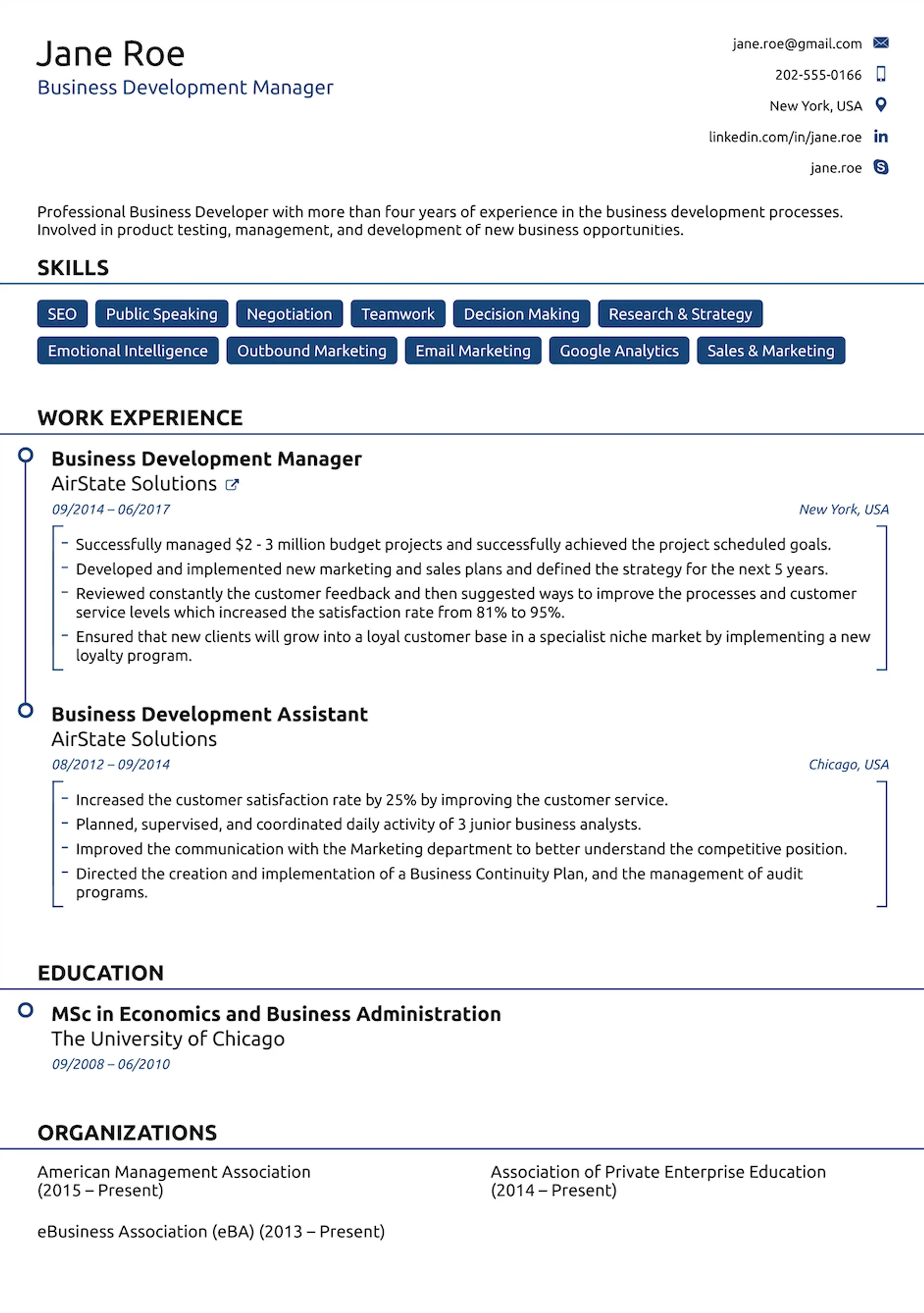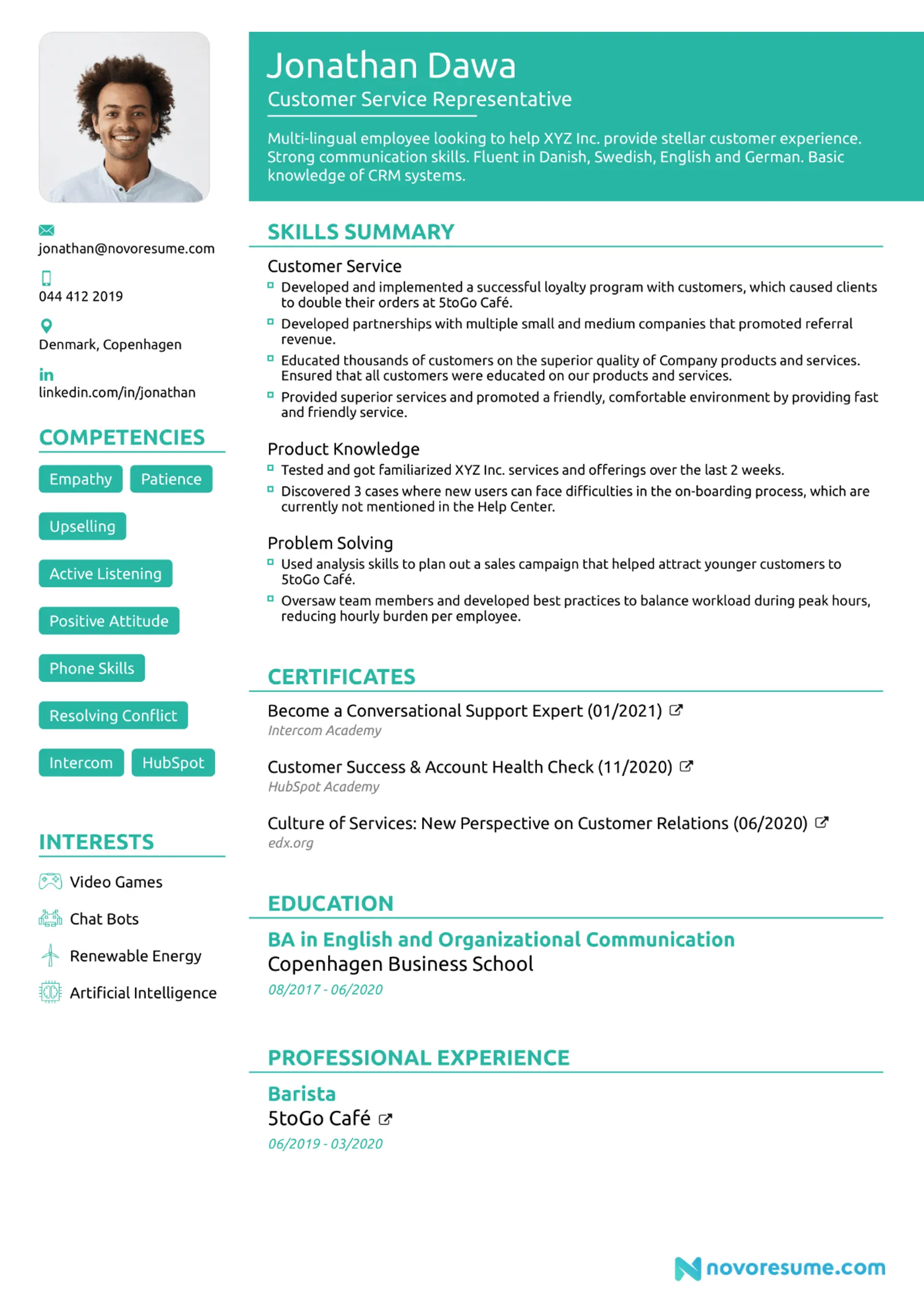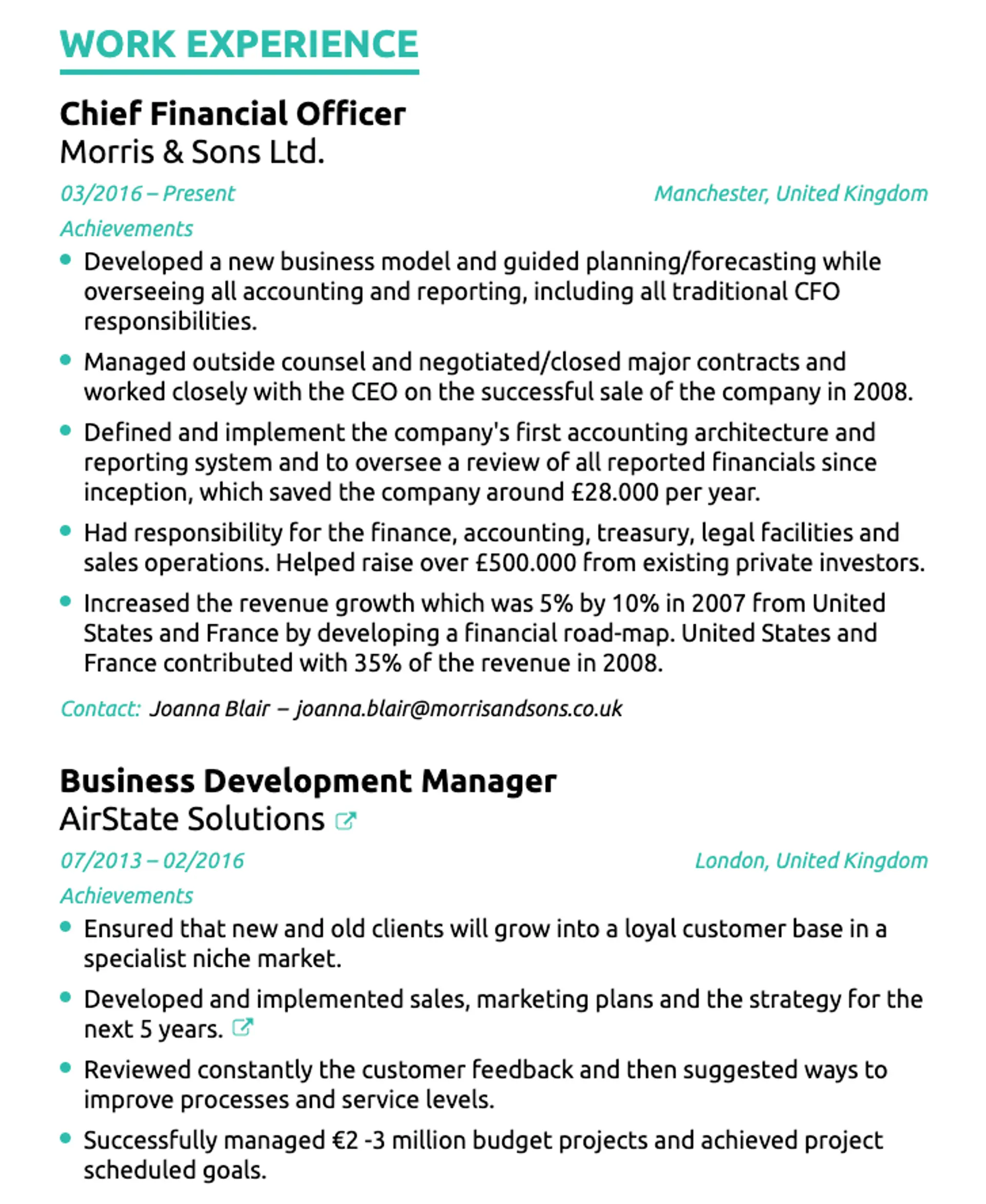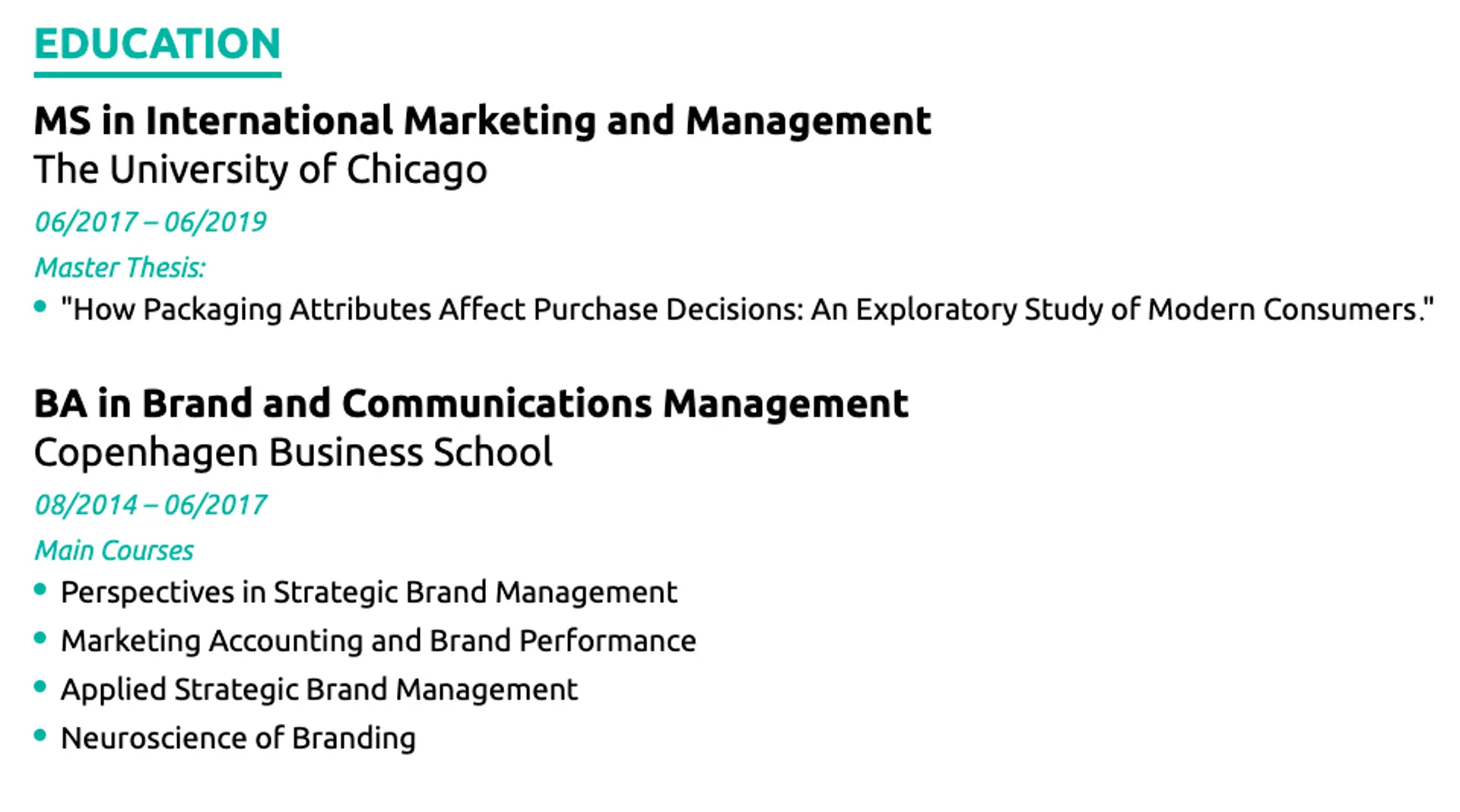
Have you ever thought of what one can do in 7 seconds? Probably not much, right? That’s not even enough for an elevator ride!
Well, turns out that’s exactly how much time recruiters spend skimming over a resume before deciding if the applicant’s to be considered or not.
In those 7 seconds, you have to convince the recruiter that your resume is relevant and they should read the rest of it.
So - how can you make that happen?
Well, you need to use the right resume sections, and fill in the contents the best way possible.
And in this article, we’re going to teach you all about how to do that!
More specifically we’ll go over:
- What are the essential resume sections and categories
- How to order resume sections according to your career level
- How to best structure each section and section entry
- 5+ Resume structure tips (to help you along the way!)
There’s a lot to learn, so let’s get started right away!
What to Include In Your Resume - 10 Essential Resume Sections
Some resume sections you really can’t argue on & there’s a place for them on every single resume out there:
Your resume should and must include the following:
- Contact Information
- Resume Summary/Objective
- Work Experience
- Education
- Skills
After you’ve made sure you have all of the above, depending on your professional level or job position, you can include any of the following optional sections:
- Extracurricular Activities
- Projects
- Languages
- Volunteering Experience
- Hobbies & Interests
Since (in most cases) your resume should not go over one page, you want to be strategic about which optional sections to include.
Typically, you should go for the ones that are most relevant to the position you are applying for. E.g. If you're applying for a role in customer support, a languages section would be the most helpful.
How to Order Your Resume Sections
Depending on your level of work experience, you’d want to order your resume sections differently.
If you’re a recent graduate, for example, you’d want to put more emphasis on your education and skills than work experience.
In this section, we’re going to teach you how to correctly order your resume structure, starting with:
#1. Reverse-Chronological Resume Structure
The reverse-chronological resume format is the most popular resume structure in 2026.
It emphasizes the applicant’s work experience and skills, so it’s the go-to for most professionals.
The entries are listed in reverse-chronological order - hence the name - which makes it easy for recruiters to follow.
If you’re using this structure, you’d list the sections in this order:
- Contact Information
- Resume Summary or Objective
- Work Experience
- Skills
- Education
- Optional Sections
Which usually looks like this:

#2. Recent Graduate Resume Structure
As a recent graduate, you usually don’t have an extensive work experience history.
Instead, your skills and extracurriculars will be the main focus of your resume.
This calls for a totally different structure from the reverse-chronological one, with the sections being ordered as follows:
- Contact Information
- Resume Summary or Objective
- Education
- Skills
- Work Experience (if applicable)
- Optional Sections
Which looks like this on a resume:

#3. Career Change Resume Structure
Career change resume structure is a bit more complicated.
While you do have work experience, it’s not actually relevant for the jobs you’re applying for.
So, what does that mean in terms of resume structure?
We recommend structuring your resume as follows:
- Contact Information
- Resume Summary or Objective
- Skills
- Work Experience
- Optional Sections/Education
- Education/Optional Sections
Which looks like:

How to Fill In Your Resume Sections - Our X+ Top Tips
Now that we’ve covered the basics, let’s deep-dive into each of these sections and teach you how to get them right!
Starting with:
#1. Contact Information
Starting off your resume, right at the top of the page is the Contact Information section.
Despite the positioning, you’d think the section is at the bottom of the list of important sections. Wrong!
Sure, the education and work experience sections are the stars of the resume, but what happens if you’ve given the wrong contact information and the recruiter can’t contact you?
You see the importance of the section now, right?
It’s crucial that you double - no, triple-check everything.
It’s also important that you are professional about what you’re writing down in the contacts section.
If your email address looks something like well… you better create a new one along the lines of .
Moving onto the content of the section, here’s what you should mention:
- First & Last Name
- Phone Number
- Email Address
- Location - city and country only
- Job Title/Professional Title
- LinkedIn Profile (Optional)
- Social Media (Optional)
Pro Tip:
Only include social media profiles if they are relevant to the position you are applying for.For example, as a developer, you can link to your GitHub or StackOverflow to show off your projects.Or as a writer, you can link to your personal blog or portfolio.
If you’re debating on whether to include a photo or not, your location and industry should be taken into consideration. Before making a decision, read all about it in our article on including photos in a resume or CV.
#2. Resume Summary or Objective
Part of a resume’s header, right under the contact information section, goes your resume summary or objective.
First things first, let’s talk about what a summary and objective is and when it’s best to use one or the other.
A resume summary is a 2-4 sentence rundown of your professional career that highlights your top achievements and skills. It’s typically used by professionals with plenty of relevant work experience in the field they are applying to work in.
A good summary looks something like:
- “Digital marketing professional with 5+ years of experience. Managed over 20 Google Ads accounts for small to medium-sized business, with a total budget of over $200,000 per month.”
Struggling with writing your own resume summary? Just use our tried-and-tested formula![Years of Experience] + [Profession/Field]. [Top Skills and Experiences]. [Top 1-2 Professional Achievements]
A resume objective on the other hand is a 2-4 sentence introduction to your skills and career goals (as opposed to work experience) and aims to explain why you’re a good candidate for the position.
The resume objective is usually used by recent graduates or career changers, as it has more focus on skills rather than experiences.
Over the last few years, resume objectives are being used less and less. If you do choose to include one, however, here’s what it should look like:
Resume objective example:
- “Accounting and Finance B.A. graduate with experience in financial data analysis and auditing from an internship in one of the “Big Four” firms. Looking for an entry-level Financial Analyst position to expand my skill set kickstart my career in corporate finance.”
How to get such a resume objective structure? Simply follow this formula:[Your Background] + [Desired Position]. [Top Job-Relevant Skills]. [Other Work Experiences]
#3. Work Experience
It’s time to talk about the #1 section recruiters refer to when evaluating your application - the work experience section.
As far as its positioning on a resume, the section typically comes right after the contact information section and resume objective/summary.
This changes for applicants with no work experience who’d substitute the section with something else altogether.
Moving onto the structure, each entry for your work experience resume section should look like the following:
- Job Title and Position
- Company Name (include a brief description of the company if it’s foreign or not well-known)
- Location
- Dates of Employment
- Achievements or Responsibilities
Once filled out, here’s what the section should look like:

Lastly, content-wise, the most important tip to keep in mind is to talk about achievements instead of responsibilities.
Why? Well, the tasks for a specific job position are generally the same among companies.
An accountant at Company A has the same duties as an accountant at Company B. Their achievements, however, probably differ a lot.
For example, instead of writing something generic like:
Incorrect Example:
- “Prepared financial reports”
You’ll have more success with specific achievements like:
Positive Example:
- “Spotted and fixed tax-reporting errors, saving the company over $150,000. ”
Pro Tip:
A crucial thing to remember when it comes to selecting work experiences is picking the ones relevant to the job position.Not only that, but you also need to be mindful of the wording you use. Everything should hint at you being the right fit for the job.To help you tailor your resume to the job position, go over the job posting itself, find what requirements they are looking for, and implement those into your resume using the same keywords and expressions.You can check out all the details on how to do that effectively in our article on the work experience section.
#4. Education
Typically right after the work experience section comes education.
In reverse-chronological order, list your education and format each entry according to this structure:
- Program Name
- University Name
- Years Attended
- GPA (Optional)
- Honors (Optional)
- Academic Achievements (Optional)
- Minor (Optional)
On a resume, that would look as follows:

And here are some of our top tips on making your education resume section as compelling as possible:
- First, you should consider mentioning your GPA only if it’s very impressive (3.5 and above). Keep in mind, though, that this section is optional for a reason. Recruiters don’t really care about GPAs, as they’re not a good indicator of career success. A senior vice president of people operations at Google even claimed that GPAs are “worthless as criteria for hiring”.
- Don’t include your high school diploma if you’ve already mentioned your university education - the recruiter doesn’t care where you studied for high school if you have higher education.
- If there are any interesting papers you’ve written or advanced courses related to the field, feel free to mention them.
If you’re looking for some more tips and tricks on this section, have a look at our article on how to list education on a resume.
#5. Skills
The skills section easily makes it into the top 3 most important sections in your resume and is usually positioned before or after the education section.
By going over a concise list of skills, the recruiter can quickly get a glimpse of what you can do.
You can also provide your level of expertise next to each skill by using the following scale:
- Beginner - You have some knowledge and experience with the skill.
- Intermediate - You have a good level of understanding of the skill and have previously used it in a work environment.
- Advanced - You’re fully competent in the skill, have used it extensively at work, and can coach other employees on it as well.
- Expert - You’ve used this skill on plenty of occasions in different projects and organizations. Your coworkers and even other professionals in the field can go to you for advice on the skill.
As you probably guessed, your skills should be tailored to the position and industry you are applying in.
If you’re applying for a job in finance, for example, the recruiter won’t really care about your skills in Adobe Illustrator.
One thing we do recommend doing despite the industry, however, is including more hard skills than soft skills.
Hard skills are those gained through work experience or education. They’re technical knowledge that directly helps you do your job. Think software skills, coding languages, accounting, etc.
Soft skills, on the other hand, are attributes that mostly refer to behavior, communication, and how you work. They’re gained from life experiences and apply to your job indirectly. They can be skills like creativity, teamwork, or problem-solving.
While companies prefer their employees to have people-oriented soft skills, they don’t actually expect to see these skills on a resume.
See, every other job-seeker lists skills like “teamwork,” “critical thinking,” and the like on their resume (regardless of whether they have the skill or not).
This completely devalues the skill, and recruiters don’t even pay any attention to them.
If you’re struggling with finding the right combination of skills to mention on your resume, you can look for inspiration in our list of 101+ essential skills.
#6. Optional Sections
Depending on the job position and, of course, if you have enough space left in your resume, you can add any of the following optional sections.
Are they game-changers? Not really, no one’s going to hire you as a senior developer because you know French, or as a creative writer because you play Dungeons & Dragons.
These resume sections, however, allow you to stand out from other qualified candidates.
The recruiter is more likely to hire someone, for example, who has a lot of hobbies than someone with no interests.
So, without further ado, the optional resume sections are as follows:
Languages
You never know when someone with language knowledge might come in handy at the office, so employers are very much interested in applicants with diverse language skills.
An extra language gives you an advantage over other applicants with a similar background so if you have one or more, do include them in your resume.
Hobbies & Interests
Hobbies and interests can say a lot about you, so if you’re going to mention them in your resume, carefully select ones that put you in the best light.
These would be hobbies that are relevant to the job position and emphasize your interest and skills in the field. For example, if you’re applying for a copywriting gig, you could mention an interest in D&D as it shows creativity.
Alternatively, you can simply include the section to fill up the remaining space in your resume.
While these hobbies won’t get you hired, you might find out you have something in common with your potential team leader!
Volunteering Experience
Volunteer work is always an impressive experience to add to your resume, especially if the company where you’re applying has “giving” as an important part of their company culture.
They show that you’re passionate about your beliefs and are willing to take action to pursue them.
Quite often, they can also count as work experience and help you stand out if you’re a recent graduate with no work experience.
Structure-wise, each entry should follow this logic:
- Name of the organization
- Location
- Time period
- Relevant tasks and achievements
Certifications & Awards
A little flex can never hurt your resume, so if you have any certifications or awards that testify to your skills, this is the right section to put them under.
For each entry provide:
- Name of Award/Certification
- Date(s)
You can even provide a very short description of what the certification or award is about or what it represents in the industry.
Projects
Do you have any practical projects you worked on during college? Maybe your thesis?
Or maybe a side project that you work on in your free time, like a game or a blog?
If yes, you should include a “projects” section to make sure they’re noticed and appreciated!
This will add valuable points to your application as it shows you’re a naturally curious individual and a self-starter.
On top of leaving a good impression and showing off your skills, recruiters sometimes also consider your experience with a project as work experience.
Meaning, this can really help you stand out if you’re a recent graduate.
For your projects section, format each entry like you would with your work experiences and include a bulleted list with the project’s key features. More specifically:
- Project name
- Project type
- Related organization
- Time period
- Relevant responsibilities and achievements
Extracurricular Activities
If you’re a recent graduate, this section can be one of your main selling points.
Extracurricular activities, like participation in university clubs and societies, show the recruiter you’re an active and engaged person that went beyond their academics.
It can also emphasize your skill-set. E.g. If you've organized events or conferences for a university club, it means that you can work in a team and are organized.
As with work experiences, you should write down your position, the name of the club/organization you worked for, and a shortlist of your achievements.
5+ Resume Structure Tips
Now you know what the must-have and optional sections for a resume are, what to write in each of them, and how to order them to your advantage.
You almost have it all.
There are a few more tips you need to know for a 5-star resume structure and we’re going to tell you just what they are.
Take notes and remember to:
- Stick to one page. Unless you’re a senior professional with decades of relevant work experience, there’s no excuse for you to have a longer resume. If you’re struggling with keeping at one page, use one of our one-page resume templates.
- Tailor everything to the job position. From the sections you choose to the achievements listed in your work experience, everything should be relevant and help convince the recruiter that you fit right into the job.
- Separate your sections with blank spaces or lines to make sure they are distinguishable. This also gives your resume a clean and organized look that helps the recruiter easily go over everything.
- Use easy-to-read fonts and keep them concise throughout the resume. This means formatting all the section headings uniformly and doing the same with the text under them.
- To give yourself some more space, you can narrow down the page margins. Be mindful to not overdo it, however. You risk ending up with an awkward-looking resume.
- The same warning applies to font size. Choose one small enough to give you space, but big enough to be easily readable.
Want to avoid all the hassles of formatting your resume & working on the structure? Use an online resume builder! All you have to do is pick a resume template & the builder will take care of the rest.
Key Takeaways
And that was it on resume sections and structure!
At this point, you should know everything you need to create a compelling resume & land the job.
Now, to make sure everything sticks, let’s do a quick recap of the most important learning points:
- The must-have resume sections are: Contact Information, Resume Summary or Objective, Work Experience, Education, and Skills.
- Based on your profile and job position, you can pick between these optional sections: Languages, Hobbies and Interests, Volunteering Experience, Certifications and Awards, Projects, or Extracurricular Activities.
- Different career levels need to give priority to different sections and order their resume accordingly. Students with little to no experience should place skills and extracurricular activities first. Professionals should emphasize work experience and skills. Career changers should give priority to skills, and then talk about previous experiences.
- Make sure all sections and the information in them are tailored to the position you’re applying for.
- Keep things concise and relevant so you don’t go past the one-page length limit.
